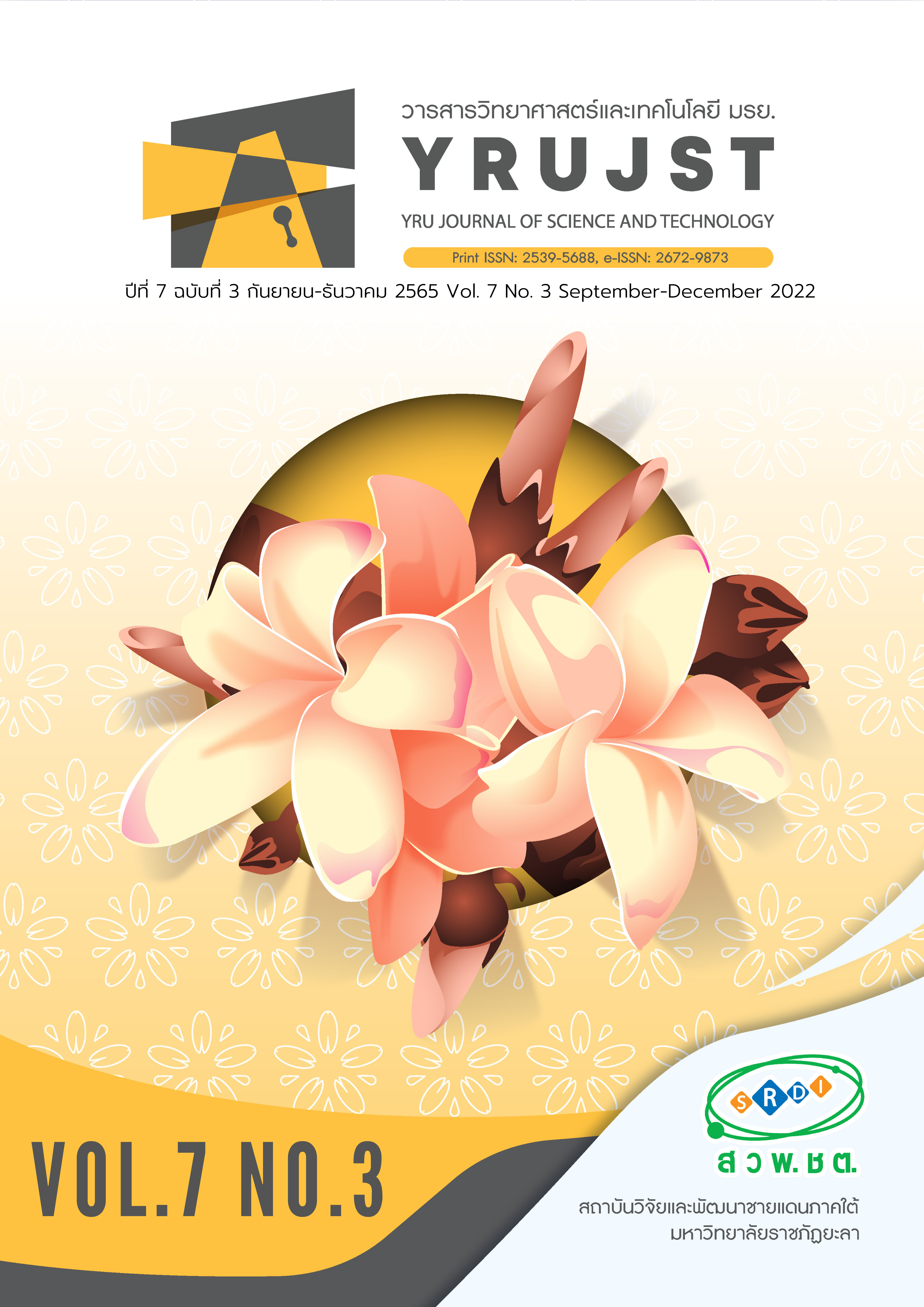Application of a Natural Dye Extracted from Heartwood of Sappan Tree (Biancaea sappan (L.) Tod.) for Chromosome Staining
Main Article Content
Abstract
The aim of this research was to extract natural dyes from the heartwood of the Sappan tree (Biancaea sappan (L.) Tod.) used for chromosome staining to replace acetocarmine synthetic dyes is available at a high price. The processing is by bringing Sappan tree for grinding, then extracted by maceration method into 5 types of solvents, which are distillation water, 95% methanol, 70% methanol, 95% ethanol and 70% ethanol. The ratio of 1:20 g/ml for 24 hours at room temperature. Then filter to extract natural dyes with No. 1 filter paper and then separated into groups to add 2 types of mordant, which are Sodium chloride and Copper sulfate at a concentration of 10% by weight per volume with a total of 15 dyes for example. From the result, highest of yield (% yield) was Sappan tree extracted with distillation water (62.80 ± 0.37%). Chemical and physical propertied were studied, it was found that all 15 dyes that were tested had acid-base status in the range of 3.30-5.95, the maximum absorption spectrum is in the range 454-520 nm. The appearance of color was measured using CIE color system to measure L* a* b * and color comparisons using the Muncel color system provided shades of yellow-red to red. The study on chromosome staining showed that the Sappan tree extracted 70% methanol and had Copper sulfate mordant. It has the best quality in chromosome staining, obviously suitable for cell division and the cell region in the metaphase is clearly visible and is the same as Acetocarmine dye. The dye quality can be maintained at 4±1 °C for at least 4 weeks.
Article Details

This work is licensed under a Creative Commons Attribution-NonCommercial-NoDerivatives 4.0 International License.
บทความ ข้อมูล เนื้อหา รูปภาพ ฯลฯ ที่ได้รับการเผยแพร่ในวารสารวิทยาศาสตร์และเทคโนโลยี มรย. นี้ ถือเป็นลิขสิทธิ์ของวารสารวิทยาศาสตร์และเทคโนโลยี มรย. หากบุคคลหรือหน่วยงานใดต้องการนำทั้งหมดหรือส่วนหนึ่งส่วนใดไปเผยแพร่ต่อหรือกระทำการใดๆ จะต้องได้รับอนุญาตเป็นลายลักษณ์อักษรจากวารสารวิทยาศาสตร์และเทคโนโลยี มรย. ก่อนเท่านั้น
References
Chaithada, P. (2019). Effect of extraction solvents and pH on the amount and stability of crude color extracted from plants. Wichcha Journal Nakhon Si Thammarat Rajabhat University, 38(1), 65-78. (in Thai)
Fakgoen, F. & Meerod, M. (2017). Extraction and separation of anthocyanins from Carissa carandas L., The 4th Research and Development Institute Kampheang Phet Rajabhat University National Conference, 22 December 2017. Kampheang Phet: Kampheang Phet Rajabhat University.1002-1011. (in Thai)
Ginesiska, G. & Herda, P. (2018). Extract of dragon fruit pule (Hylocereus polyrhizus) potentially stain chromosomes of red onion (Allium ascalonicum). Biogenesis, 6(2), 93-97.
Hoefnagels, M. (2022). Biology: the essentials (4th ed.). New York: McGraw-Hill companies inc.
Kaewpuk, W. (2018). Study of the natural dyes from plants for chromosome staining in a biological laboratory, Faculty of Science and Technology, Nakhon Pathom Rajabhat University. The 7th NPRU National Academic Conference Nakhon Pathom Rajabhat University, 30-31 March 2015. Nakhon Pathom: Nakhon Pathom Rajabhat University. 1434-1422. (in Thai)
Kongplee, L., & Pangsri, P. (2022). The development of natural dry from plants in anthocyanin group for staining plant tissue. Journal of Science and Science Education, 5(1), 1-11. (in Thai)
Kunirat, M., Dwngkhi, P., Wiriyakarun, S., & Hommuan, S. (2018). Extraction and application of natural dyes from indigenous plants for plant histological staining. Proceedings of 3rd North Eastern Science and Technology Conference, 24 March 2018. Ubon Ratchathani: Ubon Ratchathani Rajabhat university. (in Thai)
Phakpaknam, S., Wannasiri, N., & Dechikai, M. (2021). Development of chromosome staining dye extracted from black glutinous rice (Oryza sativa ver. Indica). Burapha Science Journal, 26(2), 1096-1108. (in Thai)
Pimpapon, P. (2015). A study of effects of various mordants added to the dye extracted from Litsea glutinosa (Lour.) leaves on color shades of dyeing silk thread through exhaustion dyeing process. (Master’s thesis). Pathum Thani: Rajamangala University of Technology Thanyaburi. (in Thai)
Purnendu, K., et al. (2013). Analytical chemistry (7th ed.). Manhattan: John Wiley & Sons, Inc.
Tanomtong, A., Pinthong, K., & Patawang, I. (2019). Cytogenetics (1st ed.). Bangkok: Chulalongkorn University Printing House. (in Thai)
Thongsrisuk, R., Chuaynkern, Y., Tanomtong, A., & Phansoomboon, S. (2017). Application of natural dye from purple sweet corn (Zea mays saccharate) for plant cell mitosis studies. Koch Cha Sarn Journal of Science, 39(2), 34-44. (in Thai)
Swanty, R.M. & Abdullah, M.M. (2019). Color properties and stabilizing effect of metal ion on anthocyanin from buni (Antidesma bunius) fruit. Advances in Engineering Research, 194(1), 223-225.


